|
Dog Agility Equipment
You may discover that the dog agility equipment used in competitions may vary in construction depending on an organizations rules and regulations, even so the rudimentary format of the obstacles remains the same in most agility trials. spread jump, Panel jump,Broad jump (or long jump) Tire jump, Other hurdlesTable (or pause table) Pause box Weave poles Other obstacles The
A frame
is typically made from two 3 feet (0.91m) wide by 8 to 9 feet long ramps, hinged together to form the 'A' , when erected the apex of the frame stands some 5 to 6 and a quarter feet above the ground (heights may vary according to organizations)The bottom 36 to 42 inches (0.91 to 1.1 m) of both sides of the A-frame are painted a bright color. This area is known as the contact Zone. Dog-walk 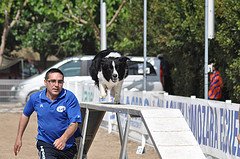
The dog walk is constructed from three 8 to 12 foot (2.4 to 3.7 m) long boards. The center board being raised 4 feet (1.2m) above the ground, with a ramp at each end, a entrance contact zone on the up ramp and an exit contact zone on the down ramp, similar to the 'A' frame thin narrow slats are attached to the ramps to aid the dogs grip. 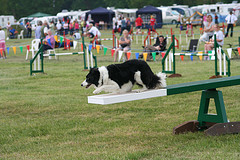
Teeter-totter The teeter-totter otherwise known as the see-saw is made from a 10 to 12 foot(3 to 3.7m) board which is set to pivot on a fulcrum (pin) again the ever present entrance and exit contact zones are to be clearly marked. Crossover The crossover obstacle is very rarely seen in competitions today having been discontinued by the kennel club in 2009 and the Agility Association of Canada. There are no major agility associations in the United States who allow the use of the crossover in competitions as too many accidents were being recorded when using this type of dog agility equipment. Tunnel 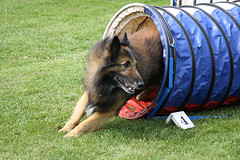
The conventional tunnel is made from a combination of vinyl tubing an average length 18' Dog Agility Training Tunnel Collapsed Tunnel 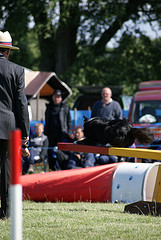
The structure of this simplistic task is a rigid cylinder chute with a cloth tube attached at one end, the cloth tube lies flat and extends approximation 8 to 12 feet (2.4 to 3.7 m). The dog enters the tube not knowing what lies at the other end, showing faith in his handlers judgment. Jumps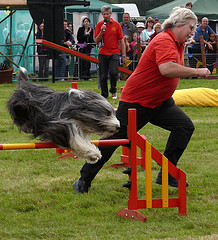
This jump is adjustable in height to permit shorter legged dogs such as the corgi to compete on equal terms with other dog breeds of a similar size Double and triple jump (or spread jump) The double bar has two upright posts supporting two horizontal bars facing forward or back from each other. Either double parallel or ascending horizontal bars are permitted. The triple jump is a similar set up but always has ascending horizontal bars,the distance between the bars is often adjusted according to the size of the dog. 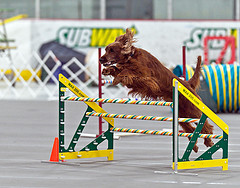
Jumps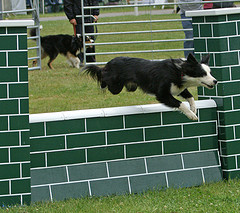
This is a solid panel jump presenting the dog with a different type of jump (the dog not being able to see through the jump to the other side), so really a jump into the unknown for the dog. The panels are constructed in sections so they may be added to or reduced to accommodate different heights of dogs Long Jump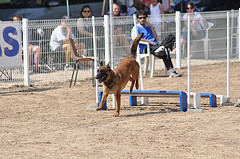
a set of 4 or 5 raised platforms that are laid out on the ground to form a wide area that the dog must clear without making contact, again adjustable for different sized dogs. Tire jump A suspended tire size hoop for the dogs to jump through, these are usually brightly colored to assist the dogs visibility enabling them to judge their jump. Pause table The pause table is the simplest piece of dog agility equipment, where the dog must come to rest for a certain period of time before continuing with the trial usually 5 seconds is the allotted time for the dog to remain sitting or in a down position. The raised platform is 1 meter square, and the height from 8 to 30 inches according to the dogs height as laid down in the various organizations rules. In some trial a simple marked off area is used for the dog to execute this task. 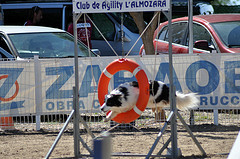
Weave Poles
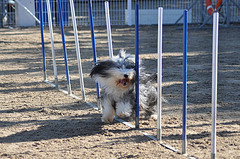
A slalom course of 5 to 12 poles each proximately 3 feet high and 20 inches apart are placed on the course for the dog to weave in and out of, commencing with the first pole in the series to his left, the next pole to his right and so on through the slalom not missing any poles. The weaving action does not come naturally to any dog making this a very difficult obstacle to overcome. Certainly in my opinion one of the most exciting to watch as it requires speed and dexterity to master.
The rewards for the tremendous efforts, Trophies for the handlers the dogs do not know if they have won or lost, they do it for the fun. All this can be started with backyard dog agility training, make your own dog agility equipment to get you started. The rewards and prizes at different levels make this a complex sport to follow as a competitor 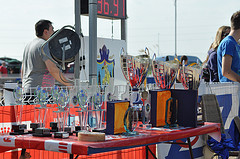
dog agility equipment to free pet advice dog agility equipment to dog agility training
|
Other Topics
Dog Agility Equipment
Dog Agility Course Plans
Agility Dog Jumping
working dogs
Dog Breeds

Jump hoop and more agility equipment





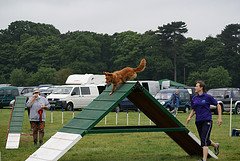 Many penalty points are incurred at this stage as the dogs will often over jump on entry or on exit in their enthusiasm, it is here that the handlers must control their dogs and steady them down.
Many penalty points are incurred at this stage as the dogs will often over jump on entry or on exit in their enthusiasm, it is here that the handlers must control their dogs and steady them down.